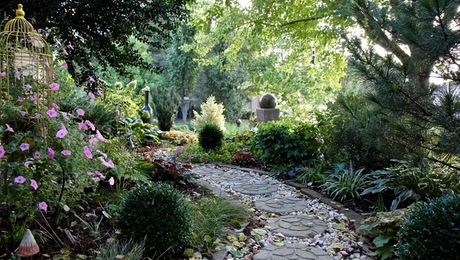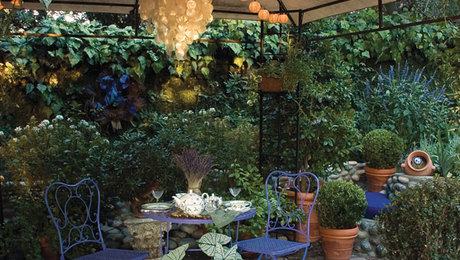The installation of landscape lighting is easy—too easy, I think. Although the lighting might be sold as a foolproof product, I’ve removed more than a few systems that were wrecks, doomed from the start by poor hardware and inferior installation. If you invest in quality materials, choose durable fixtures, and take care during the installation process, your low-voltage system will look great, perform reliably, and be easy to modify.
Choose between line voltage and low voltage

Landscape-lighting systems are divided into two types: line voltage and low voltage. Line-voltage systems operate at 120 volts (v), the same voltage found in a typical wall outlet. Low-voltage systems use a transformer to step down the voltage from 120v to a safer 12v.
Because the code requirements for installing 120v lighting are sometimes tough to follow, even for the pros, I prefer to stick to 12v systems for landscape lighting. They are a lot easier to install and are safer and more flexible for home owners to adjust and maintain on their own. Low-voltage cables are safe enough to be concealed with only a few inches of soil, mulch, or other ground cover. As a result, it’s easy to move around light fixtures and wiring as the landscape matures or is altered.
Of course, low-voltage systems have some disadvantages. Because the transformer puts out a limited amount of power, you can’t place dozens of lights on a low-voltage circuit. And although effective lighting can be accomplished with 10-watt (w), 15w, or 20w lamps, low-voltage setups don’t lend themselves to high-wattage fixtures. Also, if long distances are involved—more than 100 feet between the transformer and the farthest fixture—the wire’s resistance can cause a significant reduction in the voltage reaching the distant fixtures. This line loss makes the light from those lamps dim and yellowish. It’s not hard, however, to design and install a system to overcome voltage drop.
Lighting kits have limitations
Low-voltage lights are often sold in kits that include a transformer, a cable, and several fixtures. Kit prices can be as low as $100, but you end up buying a system that can’t be expanded or easily altered. The minimal level of the lighting and the short life span of bargain light fixtures can be (excuse the pun) a real turnoff.
I buy my components separately: a high-quality transformer, 10-gauge cable (heavier duty than the 12-gauge cable that comes with many kits), well-made metal (not plastic) light fixtures, and good cable connectors. Although a premium low-voltage lighting package costs quite a bit more, you’ll be able to power more lights and won’t be limited by the fixtures that come with the kit. You can, instead, select fixtures from different manufacturers, getting exactly the features and styles you want. The fixtures I used in the project featured here are from Vista Professional Outdoor Lighting (www.vistapro.com).
I’ve found that if the voltage reaching a low-voltage lamp falls below 11v, the output of the lamplight will be reduced and the light will appear to be dim and yellowish in color. Quality transformers have outputs that are above 12v (usually 13v, 14v, and 15v). These outputs—called “taps”—allow the circuit to be fed with a voltage above 12v so that even after the voltage is reduced by the resistance in the electrical cable, the farthest fixture still will run above 11v.
For setups like these, I follow a few rules of thumb: I keep the lamp load to about 70 percent of the rated transformer capacity; I upgrade to 10-gauge cable instead of the lighter, more common 12-gauge cable; and I try hard to keep the cable length on individual circuits 200 feet or less. If the loop is between 125 feet and 175 feet long, I use a 13v tap; if the run has to be longer than 200 feet, a 14v or 15v tap is the best bet. Some transformers also have an 11v tap, perfect for circuits that are loaded lightly or have short cable runs. Running a lamp at a bit less than 12v extends its life considerably and is hardly noticeable in brightness or light color.
Cables typically are covered, not buried
Low-voltage cables can be left aboveground safely, but for appearance’s sake, concealing the cables and the splices with some type of mulch or ground cover is a good idea. If the cables are run through an area where they are likely to be damaged by a garden shovel, an edger, or a lawn aerator, they should be buried about 6 inches deep. Otherwise, leave the cables near the surface, where they will be easier to move. As plants mature or as design tastes change, being able to uncover cable easily and move it are big advantages.
Of course, Murphy’s Law says that there will be at least one spot where you want to run cable that is blocked by a walkway, driveway, or concrete slab. If there’s a control joint or an expansion joint in the right place, I will sometimes open the joint by using an angle grinder equipped with a diamond wheel, then simply tuck the cable in the groove before resealing the joint with concrete sealer.
If there are no expansion joints to work with, often the only way to get past a wide slab or walkway is to go under it. One option is to drive a pipe through the soil, leave it in place, and run the cable through the pipe. It’s an effective solution, but it involves lots of hard work. Plus, rocky soil can make this method nearly impossible.
It’s easy and tempting to use a garden hose and needle nozzle to blast a hole under a walkway, but you need a way to get rid of the water and mud generated by this method, and it usually leaves a much bigger space than is needed for the cable. Plus, I’ve never found a really good way to backfill this type of tunneling, and leaving the underside of a wide and heavy surface unsupported can lead to large surface cracks and sinkholes.
A good lighting system needs a little attention to keep working well. Burned-out lamps or damaged fixtures have to be replaced. In addition, recessed fixtures should be cleared of leaves and dirt at least once a month. As the landscape matures, fixtures might need to be relocated. This maintenance is quick and simple, and keeps the landscape illuminated as nicely as when the system was new.
Clifford A. Popejoy is an electrical contractor in Sacramento, Calif.
Fine Gardening Recommended Products

A.M. Leonard Deluxe Soil Knife & Leather Sheath Combo
Fine Gardening receives a commission for items purchased through links on this site, including Amazon Associates and other affiliate advertising programs.


















Comments
A great solution to make your yard more comfortable and functional. I would also recommend installing smart light switches right away like https://bit.ly/3DIM9ZD that will help you better control this lighting right from your smartphone
Log in or create an account to post a comment.
Sign up Log in